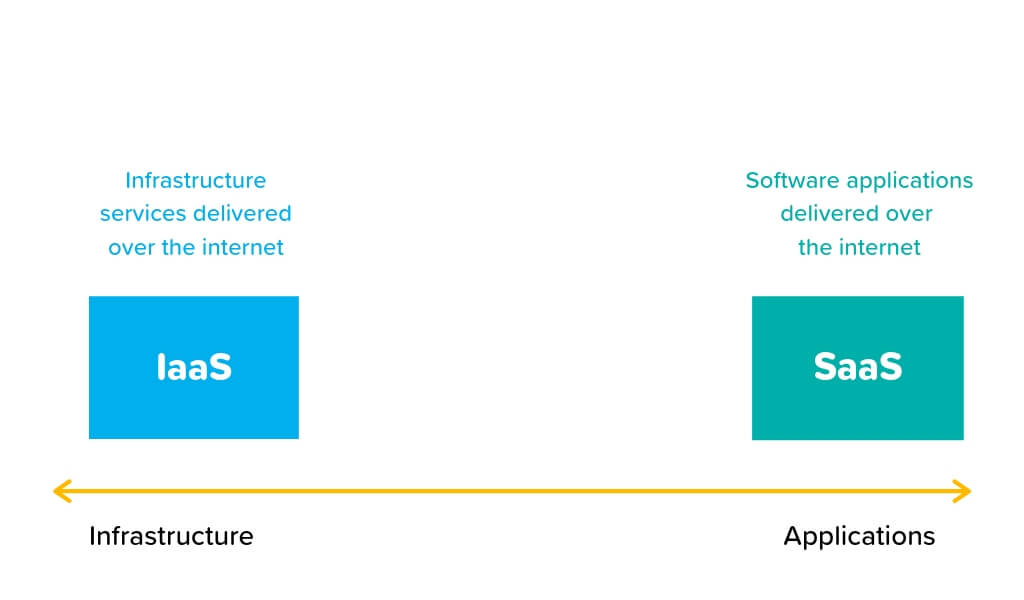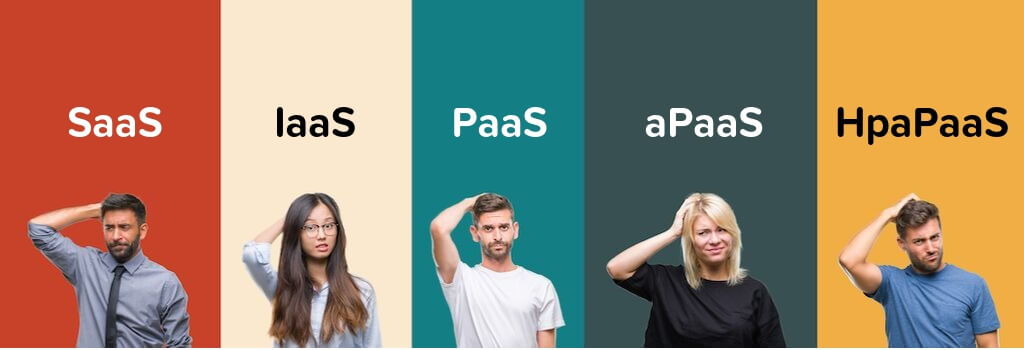The growth of internet services over the last 20 years has introduced a new set of acronyms to describe different solutions, acronyms like SaaS/IaaS/PaaS/aPaaS/HpaPaaS. These acronyms can be a little confusing, so we’ll break down the difference between them so you can find the solution that’s right for you.
SaaS (Software as a Service)
In the early days of the internet, there were only simple websites and services, and there weren't any full applications delivered over the internet. With the birth of internet, application providers like Amazon and eBay, a new category of software was born, software that could be delivered to users over the internet.
Instead of having to install expensive software on your own servers, with SaaS applications, you can access them on the internet without any setup.
Early SaaS providers like Salesforce started charging a monthly subscription to use the service, which allowed companies to buy software much cheaper at a more predictable cost. Today most companies use SaaS applications across every department, and most software today is purchased through monthly/annual subscriptions. The SaaS model has made it much easier and cheaper to deploy software applications, and has given birth to the modern cloud revolution.
IaaS (Infrastructure as a Service)
In the late 90’s, there began a simultaneous emergence of a new type of “as-a-service” technology model, the IaaS (Infrastructure as a Service) model. Amazon Web Services was one of the pioneers in this space, and they led the charge in building infrastructure services that companies could leverage. Until this time, companies had to manage their own servers and data centers, which was costly and required a lot of technical resources.
IaaS providers like AWS allowed companies to get rid of their servers completely by managing them through the internet as a service.
IaaS providers radically dropped the price of hosting, deploying and running applications by getting rid of the need to buy expensive hardware and servers. (IaaS solutions focused on delivering Infrastructure as a service over the internet, while SaaS solutions focus on delivering Applications as a service over the internet.)
RELATED: 10 Low-Code Industry Terms Explained

PaaS (Platform as a Service)
Over time, a 3rd “as-a-Service” offering emerged, the Platform as a Service offering. Infrastructure as a Service (IaaS) solutions started delivering more and more functionality revolving around software development, rather than just infrastructure management services. Platforms like Heroku were built on top of IaaS platforms like AWS to provide an additional layer of abstraction for developers to easily deploy and run their code.
Where the IaaS movement was focused on empowering infrastructure engineers, the PaaS movement was all about empowering software developers.
These PaaS offerings allowed developers to deploy, run and manage their code with minimal infrastructure work, allowing them to build software much faster. Over time, IaaS platforms started to move up the stack to provide more and more PaaS functionality. Now most of the IaaS platforms like AWS offer extensive PaaS solutions to make software development and deployment much easier.
aPaaS (Application Platform as a Service)
The PaaS movement above came from IaaS solutions delivering more up-stack functionality, moving from infrastructure controls, to development platform controls. At the same time as this shift from IaaS to PaaS, there was also a simultaneous movement from SaaS platforms developing more and more platform functionality, and this gave birth to the aPaaS (application Platform as a Service) movement.
SaaS applications like Salesforce started to move down-stack and delivered more software development functionality so that users could customize and build SaaS applications.
These aPaaS platforms were particularly useful for the new generation of “citizen developers” that want to build apps without having to learn how to code.
Many SaaS applications today provide software development functionality that moves them into the aPaaS arena. So the PaaS and aPaaS movements are very similar in some ways, because they are both focused on delivering software development services for web applications. You can see the difference between PaaS and aPaaS by looking at where they evolved from. PaaS solutions evolved out of IaaS solutions that delivered more up-stack functionality. aPaaS solutions evolved out of SaaS solutions that delivered more down-stack functionality.

(PaaS evolved out of IaaS solutions delivering more up-stack functionality, where aPaaS solutions evolved out of SaaS solutions delivering more down-stack functionality.)
ALSO READ: Low Code vs. Customized Software: What's the Difference?
HpaPaaS (High-productivity application Platform as a Service)
That leads us to the latest acronym to join the “as-a-service” ranks: the HpaPaaS (or High-productivity application Platform as a Service) solutions. HpaPaaS solutions are a further evolution on the application Platform as a Service solution, but highly focused on speed and developer productivity. HpaPaaS solutions like Kintone deliver software development solutions that help developers rapidly build web applications without having to write code.
As companies have started to empower “citizen developers” to build apps, they are starting to look for ways to maximize the amount of apps that these citizen developers can effectively build.
HpaPaaS solutions like Kintone give citizen developers the ability to rapidly turn their ideas into functioning apps.

(HpaPaaS solutions add an additional element, speed, to the mix, and provide much faster software development functionality than standard aPaaS solutions.)
Lastly, here's a funny tweet I'd like to share.
Explaining on-prem, IaaS, PaaS, and SaaS with Bacon [image source unknown, not me...] pic.twitter.com/iby8phRNDQ
— Jeff Barr ☁️ (@jeffbarr) August 2, 2017
If you know any other acronyms emerging and wanted to see our explanation, please comment below!
Don't forget to check out the latest report on HpaPaaS solutions released by Gartner. Download a free copy of the Gartner 2021 Magic Quadrant for Enterprise Low-Code App Platforms report now.
About the Author












